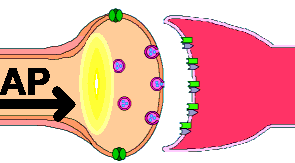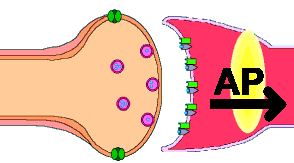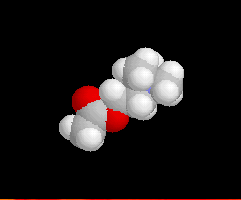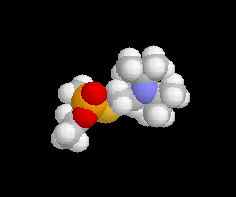
The following diagrams show how nerve impulses are transmitted by nerves at synapses:

An electrical nerve impulse (Action Potential) travels to the end of the pre-synaptic neurone. This triggers acetylcholine-containing vesicles to fuse with the synaptic knob. Acetylcholine is released into the synaptic cleft and diffuses to receptors on the post-synaptic neurone.

These acetylcholine/acetylcholine receptor interactions initiate a transmission in the post-synaptic neurone. Acetylcholine is hydrolysed by acetylcholinesterase to acetic acid and choline, and diffuses back to the pre-synaptic neurone. This regenerates the pre-synaptic neurone for further impulses.
For further details on nerve impulse transmission, and a great Shockwave animation, go to the Connecticut College Site.
VX gas may be absorbed ocularly (through the eyes), percutaneously (through skin), and by inhalation. Upon absorbtion, the phosphorous atom of VX covalently binds to a serine hydroxyl group in the active site of acetylcholinesterase (compare the two structures below).
This binding stops the hydrolysis of acetylcholine, causing constant stimulation that "fatigues" the post-synaptic neurone. The lack of acetylcholine also exhausts the pre-synaptic neurone's acetylcholine reserves.
This constant nerve stimulation causes the characteristic symptoms of VX Gas poisoning. These include:
Lower doses of VX cause similar effects, but may allow complete recovery in hours. Both VX and it's [highly toxic] breakdown products are persistent and of low votility (0.0007mmHg). This means they do not evaporate or decompose, so contaminated sites may take months to become habitable. Dispersed VX is usually broken down by rain-induced hydrolysis to an ethoxide (CH3CH2O-) ion and the nerve gas EA1292.
Though VX Gas is quick-acting and highly toxic, antidotes to the compound do exist. They are discussed in the section on antidotes.
Below are representations of acetylcholine and VX Gas molecules. If you compare the structures you'll see how similar the structures appear.
Notice the Phosphorus atom on the VX molecule (coloured yellow).
 |
 |
| Acetylcholine | VX Gas |